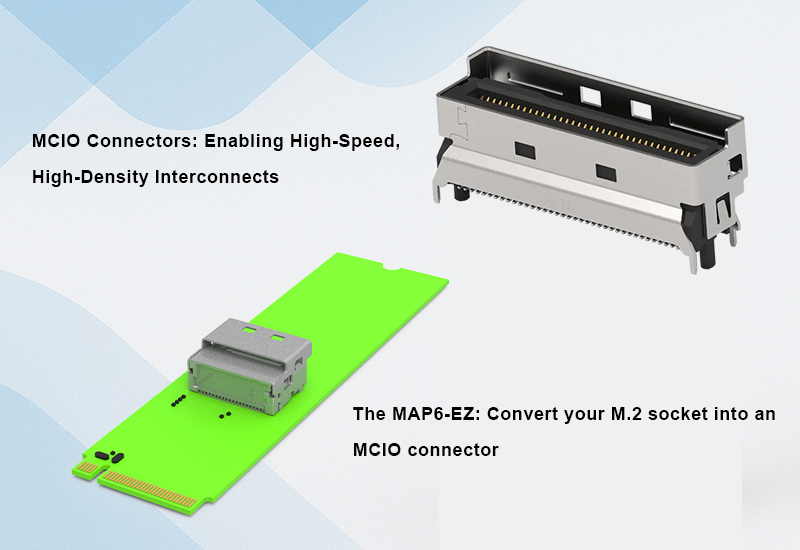- About Us
- PRODUCTS
- All Products
- Product Buyer Guide
- Internal Storage for SATA Drive
- Internal Storage for NVMe SSD
- External USB-C Storage
- HBA Card
- Converter
- Accessory
- STARDOM [ External Storage Products ]
- SUPPORT
- Knowledge
- LANGUAGE
By: RAIDONTEK Research Team

As data-intensive workloads grow and system designs become more compact, modern servers and storage architectures demand interconnect solutions that are faster, smaller, and more scalable. The Mini Cool Edge I/O (MCIO) connector—such as ACES Group’s 0.6 mm pitch, 74-position vertical model—is engineered precisely for these environments.
Combining high bandwidth, signal integrity, and compliance with PCIe Gen5 and SNIA SFF-TA-1016 standards, MCIO is becoming a critical component in next-generation computing platforms.
This white paper provides system architects, hardware designers, and product decision-makers with a detailed look at MCIO’s capabilities, real-world applications, and business value.
The MCIO connector’s design balances density, speed, and versatility—making it an ideal choice for high-performance, space-constrained systems.
| Feature | Benefit |
|---|---|
| High-Speed Performance | Supports up to 56 Gb/s (PAM4), aligned with PCIe Gen4/Gen5 standards. |
| Standards Compliant | Fully compatible with SNIA SFF-TA-1016, ensuring interoperability. |
| Compact Form Factor | 0.6 mm pitch and low-profile housing conserve valuable PCB space. |
| Flexible Configurations | Available in 38, 74, and 124 positions with vertical or right-angle mounting. |
| Dual-Use Design | Supports both cable termination and card-edge mating for modular designs. |
| Durable Build | Gold-plated contacts, high-temp LCP housing, and operation from –40 °C to +85 °C. |
These features enable MCIO to integrate seamlessly into modern board layouts while supporting the speed and flexibility required by today’s high-performance components.
Beyond physical dimensions, the true strength of MCIO lies in its ability to maintain clean, reliable signals at multi-gigabit speeds. The connector’s design is tailored to ensure robust signal performance across PCIe Gen4 and Gen5 environments.
● Precision Gold-Plated Contacts: Dual-row pins ensure tight alignment and low contact resistance.
● Differential Pairing: Balanced signal paths reduce EMI and crosstalk for clean data transmission.
● Controlled Impedance (~85 Ω): Supports consistent PCIe/NVMe performance over complex routes.
● Signal Isolation: Ground pin placement and optional shielding help prevent interference.
● High-Strength Housing: Low-profile, high-temperature LCP ensures reliable mating and mechanical durability.
These capabilities allow MCIO connectors to maintain bandwidth and signal integrity even across extended cable lengths—critical in high-density, high-speed applications.
MCIO isn’t just a high-performance connector—it plays a vital role in enabling modular storage designs by bridging PCIe lanes between motherboards and remote NVMe M.2 sockets.
Traditionally, M.2 connectors are fixed endpoints on the motherboard. However, MCIO enables flexible storage scaling by acting as a high-speed PCIe bridge to expansion boards or backplanes populated with M.2 drives.
● A server motherboard includes MCIO ports.
● Cables connect these ports to a secondary board housing multiple NVMe M.2 SSDs.
● Increases NVMe Capacity without overcrowding the motherboard.
● Enables Modular, Hot-Swap Designs for easier maintenance and serviceability.
● Maintains PCIe Gen4/Gen5 Speeds across cable lengths up to ~1 meter.
This separation between controller and storage endpoints enhances design flexibility, reduces thermal congestion, and simplifies NVMe scaling in high-density systems.
● MCIO connectors are increasingly adopted in systems where space, performance, and modularity are critical. Below are common deployment scenarios:
● Enterprise Servers: Use MCIO to connect motherboard ports to front-access NVMe SSD bays via high-speed cabling.
● Storage Arrays: Route PCIe lanes to M.2 connectors mounted on hot-swap sleds or expansion modules.
● High-Performance Workstations: Enable PCIe cable routing for NVMe drives without consuming valuable motherboard real estate.
● Modular Blade Systems: Support dense, flexible architectures with cable-based PCIe lane distribution.
Thanks to its physical and electrical design, MCIO supports scalable system architectures across varied enterprise environments.
MCIO connectors represent a premium interconnect solution—with higher material and engineering costs than legacy connectors. However, these costs are often offset by long-term system advantages.
| Category | MCIO Connectors | Standard Connectors (PCIe, SATA, USB, etc.) |
|---|---|---|
| Connector Cost | ~$4–$5 per 74-pin connector | Typically<$1 per unit |
| Cable Assemblies | Tens of dollars for high-speed assemblies | Lower-cost or integrated cables |
| Materials & Design | Fine-pitch, gold-plated, high-temp LCP | Simpler, tin-plated, lower-grade plastics |
| Production Volume | Enterprise-grade, lower volume | Mass-market, high volume |
● Reduces Redesign Costs with flexible, cable-based layouts.
● Improves Serviceability with hot-swap and modular storage.
● Supports Future Upgrades without requiring full board rework.
● Enables Higher System Performance for competitive advantage.
While initial costs may be higher, MCIO’s long-term return on investment makes it a strategic choice for performance-critical systems.
The MCIO 0.6 mm pitch connector is a future-ready solution designed to meet the evolving demands of data infrastructure. With industry-standard compliance, high-speed capability, and a compact, flexible form factor, MCIO enables scalable, modular system designs across a wide range of applications—from servers and workstations to storage arrays and HPC clusters.
By bridging PCIe lanes to NVMe M.2 and other endpoints, MCIO enhances performance, increases design flexibility, and reduces space constraints—making it a powerful investment for modern and next-generation enterprise systems.
| Return |
RaidonTek.com (raidon.com.tw) uses cookies to improve site functionality and your overall experience by storing necessary information for service delivery. By continuing, you consent to our use of cookies as detailed in our Privacy Policy, which provides more information about this usage. (Accept cookies to continue browsing the website)